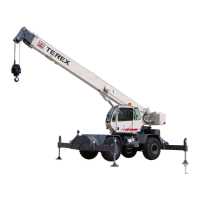Tire Maintenance
MAINTENANCE CHECK
As a part of the WEEKLY MAINTENANCE, inspect the tires and rims for damage. Cuts and
bruises, snags, punctures, and abrasions should be repaired before they can cause tire
failure. Bent, cracked or loose rims should be repaired or replaced.
Check tire valve condition and make sure each valve has a cap.
Check the wheel retaining nuts for proper tightness. Wheel retaining nuts should be
torqued to 400-500 ft.lbs.
TIRE PRESSURES
Always maintain the recommended tire inflation pressures in all tires.
When driving, some increase in tire pressures can be expected due to heat generated by
friction. Overspeeds may also produce increased tire pressures. In such circumstances,
NEVER BLEED THE TIRES. Instead slow down or stop until the tires cool.
Inflation pressure should be checked when tires are cool, using an accurate tire pressure
gauge. Check pressures at regular intervals.
Bleeding the air from hot tires is dangerous and should not be attempted. While the
pressure will be reduced, an increase in temperature of the tire will take place as soon as
driving is resumed and tire failure will result.
UNDERINFLATION
Too little air pressure increases deflection, causes the tread to wipe and scuff over the
road, results in extra strain on the tire, and increases the chances for bruising.
PROPER INFLATION
Maintaining the proper air pressure provides maximum road contact and results in
increased tire life.
OVERINFLATION
Overinflation reduces tire deflection and tire contact area, causing the tire to ride on the
crown, and results in rapid wear in the center of the tread.
Maintenance
144 P/N 12261-319 REVISED: August 2012
Courtesy of Crane.Market

